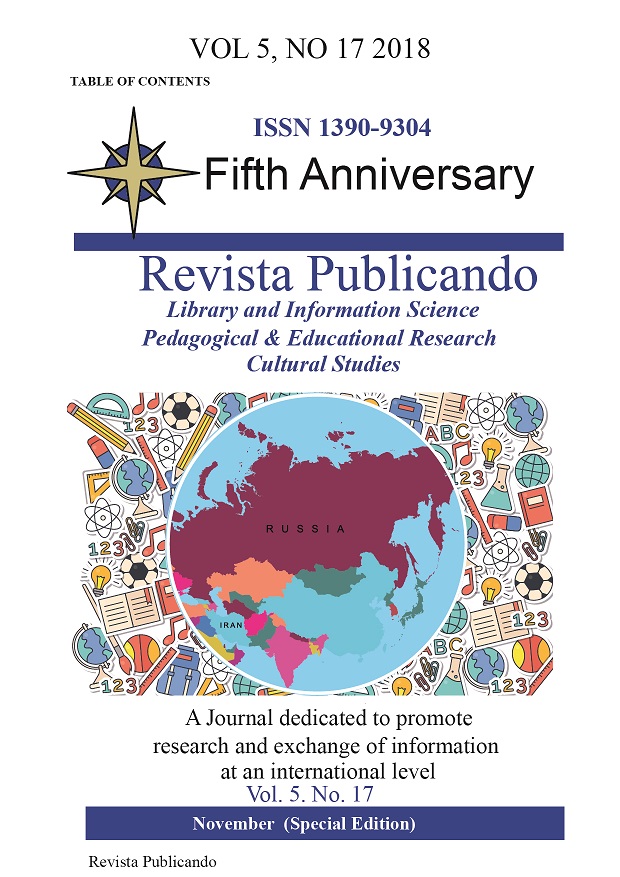Resumen
We have studied personality traits of the gifted freshmen students of Department Design and National Arts of Institute of Philology and Intercultural Communication L. Tolstoy, Kazan Federal University. A total of 40 students aged 17-19 participated in the study. We used the following methods: Mini-Mult abridged version of the Minnesota Multiphasic Personality Inventory, the method of assessing the level of neuro-emotional stability, degree of integration of personal properties, the level of individual adaptation to the social environment; Eysenck Personality Questionnaire (EPI) defines extraversion (orientation of the personality to the outside world) and neuroticism (the result of an imbalance of excitation and inhibition - properties underlying temperament); Lí¼schercolour test measures the psycho-physiological state of a person, reveals the emotional and character logical basis of the personality and characteristics of its current state.
As a result of the EPI test, the number of extroverts in the study group is a little more than a half, and the rest of the examinees are of a mixed type and introverts. The Mini-Mult test showed a high level of the emotional stability of the students. It is associated with reduced sensitivity to the environment with a relatively low social climate sensitivity.
Correlation analysis, that allowed us to study the structure of diagnosed indices, showed that there is a legitimate interdependence of emotional state (determined by means of the Lí¼schercolour test) and personal qualities (defined with the help of Mini-Mult, EPI test). The results of this study will enable to complete the elective courses groups most effectively, as well as to distribute creative tasks and to do psychological adaptation training in a more goal-oriented manner.
Referencias
Heller, K.A., Mí¶nks, F.J., Subotnik, R., Sternberg, R. (2000). International handbook of giftedness and talent. Social and emotional development and the personal experience of giftedness, (2), pp.203–212.
Gross, M.U.M. (2002). Social and emotional issues for exceptionally intellectually gifted students. The social and emotional development of gifted children, pp.19–29.
Grobman, J. (2006). Underachievement in Exceptionally Gifted Adolescents and Young Adults: A Psychiatrist”™s View. Journal of Secondary Gifted Education, 17(4), pp. 199-210. DOI: from https://doi.org/10.4219/jsge-2006-408
Aurel, I.C. (2013). Adaptation and Stress for the First Year University Students.Procedia - Social and Behavioral Sciences, (78), pp. 718–722.
Betts, G.T, Neihart, M.F. (1985). Eight effective activities to enhance the emotional and social development of the gifted and talented: Roeper Review. Journal on Gifted Education, (8), pp. 18-23.
Well-Being. (2015). The Relationship Between Intelligence and Psychological. Well-Being in Incoming College StudentsPsychology of Well-Being Theory, Research and Practice 5:4 DOI: 10.1186/s13612-015-0029-8.
Field, T., Harding, J., Yando, R., Gonzalez, K., Lasko, D., Bendell, D., Marks. (1998). Feelings and attitudes of gifted students. Adolescence, 33, 331
Burlachuk, H.F., Burlachuk, L.F., Morozov, S.M. (1999). Thepsychodiagnostics glossary, guide. St. Petersburg: Peter Combe, p. 528.
Butcher, J.N., Dahlstrom, W.G., Graham, J.R., Tellegen, A.M, Kaemmer, B. (1989). Minnesota Multiphasic Personality Inventory-2 (MMPI-2): Manual for administration and scoring. Minneapolis: University of Minnesota Press.
Luscher, M., Scott, I. (1969).The Luscher Color Test. New York: Random House.
Bazyma, B.A. (2005). The color psychology: Theory and Practice. B. A. Bazyma. - M: Speech, p.205.
Zaitseva Lyubov, V., Mayorova Irina, M., Fedorenko Marina, V., (2018). Gifted Students' Personal Features Comparative Analysis Depending on Style Preferences in Painting, HELIX, 8(1), pp.2858-2862.
Viktoriya, V., Potapova, Marina, V., Fedorenko. (2015). Concerning Investigation of the Cultural Dyssinchrony of the Mental Development of Intellectually Gifted Teenagers, The Social Sciences. 10(7). pp. 1928-1931.
Fedorenko, M.V., Bykova, S.S. (2016).Work of the psychologist on correction of senior preschool children self-esteem, International Journal of Environmental and Science Education, 11(9), pp. 2773-2783.
Fedorenko, M., Potapova, V. (2014). Interrelation of emotional intelligence, aggressiveness and anxiousness indicators of students of pedagogical specialties: gender differences study, Life Sci J, 11(7s). pp. 453-456.
Usted es libre de:
Compartir — copiar y redistribuir el material en cualquier medio o formato
Adaptar — remezclar, transformar y construir a partir del material
La licenciante no puede revocar estas libertades en tanto usted siga los términos de la licencia
Bajo los siguientes términos:
Atribución — Usted debe dar crédito de manera adecuada, brindar un enlace a la licencia, e indicar si se han realizado cambios. Puede hacerlo en cualquier forma razonable, pero no de forma tal que sugiera que usted o su uso tienen el apoyo de la licenciante.
NoComercial — Usted no puede hacer uso del material con propósitos comerciales.
CompartirIgual — Si remezcla, transforma o crea a partir del material, debe distribuir su contribución bajo la lamisma licencia del original.
